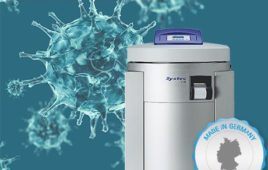A study funded by the U.S. Occupational Safety and Health Administration (OSHA) entitled Health and Safety in the Cleaning Services Industry was released in 2009. The study found that the number of Hispanic workers injured on the job in the U.S., when compared to non-Hispanics and whites, was considerably higher. And as far as work-related deaths, the study also reported, “In the United States, the proportion of Hispanic or Latino workers that die in the workplace is higher than that of other workers. Although the rate of work-related deaths has decreased generally over the years, it has not decreased among Hispanic or Latino workers.”1
This report focused primarily on the professional cleaning industry, as the title of the study implies, and this is an industry in which many Hispanic and other foreign-born workers are employed. So why are we discussing this study with the administrators of cleanroom environments? There are two important reasons that apply to all types of workers, not just custodial workers.
1. A large percentage of the Hispanic workers in the professional cleaning industry — as well as other service industries — either do not speak English or speak English as a second language, with fluency and understanding varying considerably.
2. Many injuries and deaths could be prevented, and injuries could be less severe, if workers could read and understand the MSDS (Material Safety Data Sheet) which accompanies every professional cleaning product or chemical product sold in the U.S.
These are two of the key reasons that OSHA, working in conjunction with the U.N. Globally Harmonized System (GHS) of Classification and Labeling of Chemicals, undertook a fairly massive project over the past few years that has now come into fruition. The project was to convert the MSDS, which had always been very dependent on words and must be written in English (although it may be translated into other languages) into the SDS, or Safety Data Sheet. The new SDS keeps words to a minimum2, replacing them with pictograms or icons specifically designed and selected because they can be understood in just about any language by any worker.

Image: OSHA
Other reasons for making the change include the following:
• Relieve confusion in the workplace as to how to handle hazardous chemicals and deal with chemical-related accidents — sometimes serious accidents.3
• Make it easier to train workers on the use of certain products.
• More consistent information with little or no need for translation of information on these products, no matter where they are used.
• Remove trade barriers by harmonizing warning systems for manufacturers around the world.
What exactly is an MSDS/SDS?
So we are all on the same page, an MSDS and the new SDS are designed to provide information and instructions on what to do when an emergency, such as a chemical spill, occurs. It is the responsibly of the manufacturer, in this case the chemical manufacturer, to provide the MSDS/SDS and list such things as:
- Name of the product and its intended use
- Key ingredients in the product, including hazardous ingredients
- Name, address, phone number, and emergency phone number of the manufacturer
- Flashpoint, meaning at what temperature the product may become flammable
- Precautions as to safe handling.
Further, while the original MSDS focused primarily on American workers, the new SDS not only applies to Hispanics or foreign-born workers in the U.S. but to workers all over the world. The goal, and why the U.N. was centrally involved in the project, was to ensure that a worker in a Hong Kong hotel or in a Peruvian office building has access to the same exact information, precautions, and steps to take in an emergency as does an English-speaking worker in the U.S.
Resistance and staggered introduction
While the reasons for the new SDS are fairly clear to see, along with the features and benefits it offers, it cannot be denied that some manufacturers, at least in the professional cleaning industry, voiced some resistance to the program and its implementation. One of the key reasons was costs.

Image: OSHA
While the users of these products may not realize it, considerable costs go into designing product labels, marketing materials, and related information about products. Many of these materials, including the MSDS, were produced and designed by outside vendors. Further, in exchange for product discounts, labels and marketing material on many products were ordered years in advance.
Because of this, the SDS was introduced in stages, giving manufacturers and distributors of these products, as well as end customers, time to minimize these costs and for end-customers specifically, time to get to know the new format. The conversion from MSDS to SDS began in 2012 — by June 1, 2015, chemical manufacturers were required to start using the new SDS labeling format. The old MSDS format could no longer be used on new products after Dec. 1, 2015. By June 1, 2016, all labeling must be in compliance. Also by June 1, 2016, employers are instructed to ensure their workers using products with an SDS label have a complete and full understanding of the “signal words” used, along with the pictograms and icons used to identify hazards.

Image: OSHA
Key facts about the new SDS
In many ways, the new SDS has all the information that the old MSDS had except for the most part the SDS uses icons4 and not words.
However, there are other differences. For instance, the new SDS has 16 sections instead of 9 as on the old MSDS. The new sections take into account what could be referred to as environmental issues. Some of the new sections include Section 12, Ecological information; Section 13, Disposal considerations; Section 14, Transport information; and Section 15, Regulatory information.
Other changes require that if chemicals imported into the U.S. are determined to be hazardous, they must be classified as such by their manufacturer.
The look of the SDS has changed as well. The MSDS was usually written in small black print on a white background. The SDS must also be on a white background, but framed with a red border to make it more of an attention-grabber and harder to overlook. Further, training on how to understand the new SDS is now required. Previously, in most situations, there were no requirements that workers be taught how to read and understand an MSDS.

Image: OSHA
In addition, questions often arise as to how long the information on an SDS is valid. Like the MSDS, the SDS must be updated whenever a manufacturer becomes aware of “significant new data” about its product. An example would be if the ingredients have changed. A date must also be posted as to when the SDS was updated.
Now the next step is up to you. As mentioned earlier, employers and managers in all types of industries, including cleanroom environments, are required to be familiar with the new SDS format and make sure their staff understands them as well. As we discussed, while there is always some confusion and resistance to a new system, the changes are necessary not only because they help eliminate confusion, but because we are now in a global economy. If we don’t all speak the same language, at least we can use a visual language that is widely understood to improve the health and safety of a significant sector of the global workforce.
Sidebar:
• 4,679 workers were killed on the job in 2014.
• On average, almost 90 workers a week — about 13 each day — die of their injuries.
• 789 Hispanic or Latino workers were killed from work-related injuries in 2014 — on average, more than 15 deaths a week or two Latino workers killed every single day of the year, all year long.
• Fatal work injuries involving contractors accounted for 17 percent of all fatal work injuries in 2014.
Statistics provided by OSHA.
References
1. Health and Safety in the Cleaning Services Industry, prepared by the Interfaith Worker Justice, funded in whole or in part with federal funds from the Occupational Safety and Health Administration, U.S. Department of Labor, under grant number SH20850SHO; 2009.
2. The SDS format does allow for the use of “signal words.” Examples of signal words are “Danger,” “Warning,” and “Caution.”
3. https://consumer.healthday.com/encyclopedia/work-and-health-41/occupational-health-news-507/janitors-and-custodians-646464.html
4. https://www.osha.gov/dsg/hazcom/pictograms
Terry Sambrowski is the executive director of the National Service Alliance LLC, one of the largest group purchasing organizations for the professional cleaning and related industries. www.nansa.org
This article appeared in the July/August 2016 issue of Controlled Environments.



